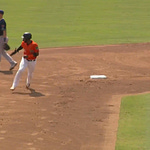In Sunday’s Red Sox–Blue Jays game, a subtle but important baserunning situation unfolded — the kind of moment that rarely shows up in a box score but often separates disciplined teams from disorganized ones.
The play began with Jarren Duran putting a ball in play and Trevor Story running on the pitch from first base. It’s a common enough sequence. But what makes it a real teaching point is what happens next — and what could have happened.
Story manages to reverse course and get back to first safely after the ball is caught, avoiding what would’ve been a routine double-up. It’s a win, but it’s also a warning. Because more often than not, this is where runners get burned.
The Risk: Running Blind
This is one of the most frequent base running mistakes in baseball: the runner on first takes off on a steal or hit-and-run, the ball is put in play — often in the air — and the runner never looks up.
They’re locked in on second base. Head down. Full speed. And then it’s too late.
That’s how you get doubled off. And for coaches, it’s one of those teachable moments that has to move beyond telling players to “be heads-up.” You have to define the moment and train for it.
The Teachable Moment: Training the Instinct
The sound of the bat has to act as a trigger.
Once a runner hears contact, especially when they’re stealing or running on the pitch, their instinct needs to be:
Find the ball.
Pick up their base coach.
Make a decision.
This doesn’t mean you slow down. It means you become more aware without killing your momentum. Trevor Story handled this well — whether it was a designed read or instinct, he located the ball, recognized the situation, and reversed course just in time.
Second Example: The Retouch Rule Gets Messy
We saw a similar breakdown in the Cardinals–Cubs game a few days prior. Runner breaks on the pitch, the outfielder makes a shoestring catch, and the runner overruns second base. He gets deked by the infielder, fails to retouch correctly, and the appeal gets him called out.
Now we’ve gone from awareness to understanding the rules. Once a runner passes a base, they’re on the hook for properly retouching if the ball is caught. This isn't intuitive to most players — especially at the amateur level.
How Coaches Can Address This:
Film It. Teach It. Don’t just tell your players to “watch the ball.” Show them clips like these and break down where awareness failed or succeeded.
Simulate It in Practice. Run hit-and-run reps with live or soft toss. Make players react to line drives and fly balls. Add a coach calling “catch!” late in the play to simulate an outfielder catching it on the run.
Drill Retouches. Have players practice running to second, breaking it down, and getting back to first legally. Build in the decision-making so they recognize the risks.
Teach the Language of the Game. Runners need to know that once they pass a base, they’re in different territory. The rules change. Understanding what “retouch” means and what triggers an appeal is crucial.
Final Thought
Base running isn’t just speed — it’s awareness, anticipation, and situational control. Plays like this don’t lead SportsCenter, but they win games. The more we slow them down and teach the layers, the more our players can speed up — and stay safe — when it matters most.












Share this post